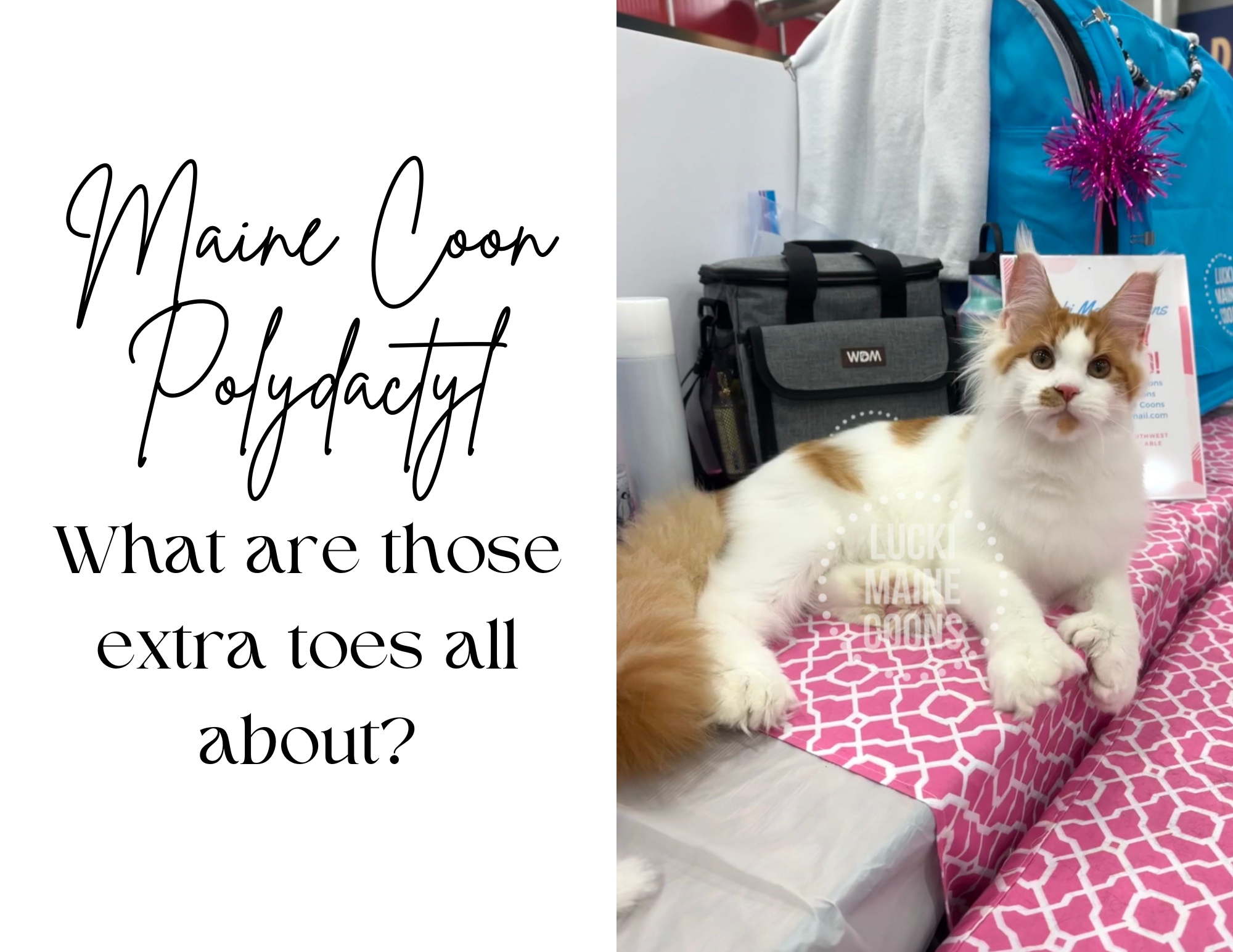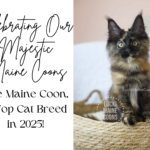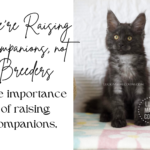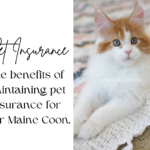Polydactyl Maine Coons or Maine Coon Poly!
Maine Coons are one of the most popular cat breeds in the United States. Polydactyl Maine Coons, also known as Maine Coon Poly or “Poly Coons” are just a bit extra special and fun with their extra toe beans. You may not realize, though some Maine Coons are born with this inherited genetic trait.
Polydactylism in Maine Coons is inherited as an autosomal dominant trait with variable expression. You must have a polydactyl Maine Coon to have a polydactyl Maine Coon kitten, each kitten has a 50% chance of inheriting this trait from a parent. However, it is not guaranteed that a polydactyl cat will always have a polydactyl kitten. It is important to note, polydactylism in Maine Coons is not a harmful trait, it is naturally occurring in the Maine Coon breed and should be considered as an innocent phenotypic variant within the breed.
Maine Coons that are not polydactyl have five toes on each of their front paws and four toes on each of their back paws. Polydactyl Maine Coons can have up to seven toes on each of their paws, generally with the maximum and less common number being eight. Since polydactylism is an inherited autosomal dominant trait with variable expression, the extra digits may vary from one paw to all four paws, with the number of toes varying per paw. Most commonly, Polydactyl Maine Coons have extra digits on both front paws or all four paws. Some call this two wheel drive or four wheel drive. Two wheel drive refers to front paws being polydactyl, four wheel drive refers to all four paws being polydactyl.
Maine Coon vs Maine Coon Poly
You may be wondering what the difference is between Maine Coon and Maine Coon Poly or Polydactyl Maine Coons. The difference between the two is that ‘Poly” refers to polydactylism, polydactyl Maine Coons have extra digits. The International Cat Association (TICA) groups Maine Coons that are not polydactyl and Maine Coons that are polydactyl separately, hence Maine Coon & Maine Coon Poly. You may see breeders that have both refer to the non-polydactyl as straight or standard paw. We refer to them as Maine Coon or Maine Coon Poly. It is important to note, polydactylism in Maine Coons is not a harmful trait, it is naturally occurring in the Maine Coon breed and should be considered as an innocent phenotypic variant within the breed. The only main difference between a polydactyl Maine Coon and a non poly Maine Coon are their extra digits and claws. Polydactylism poses no threat to the health or wellbeing of Maine Coons. The polydactyl gene is a harmless genetic trait. We have personally not experienced any ill effects of the polydactyl gene in our Maine Coons.
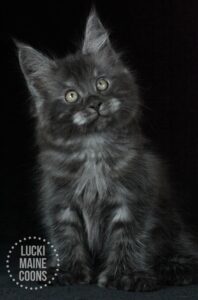
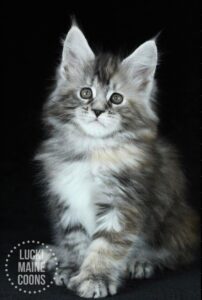
As you can see above, Controversy and Paisley Park are both Maine Coon Poly kittens as they have extra digits on all four paws. They inherited this trait from their mother, Katniss. Katniss is also polydactyl on all four of her paws with 6 digits on each. They are “mitten paw” or preaxial, meaning that their extra digits are on the inside (medial aspect) of the paw. This gives them the adored thumb like or mitten appearance.
Championship Status & Showing
Unlike some may say, Maine Coon Poly or Polydactyl Maine Coons are accepted in some organizations for showing. We have personally shown Alexa & Katniss, our Maine Coon Polys with The International Cat Association (TICA). On May 1st of 2015, polydactyl Maine Coons were accepted by TICA into Championship. Though this did not come without feat, it was achieved by a group of very determined Maine Coon exhibitors and breeders to whom we owe a big “Thank You!” to. Since their acceptance, The International Cat Association (TICA) Maine Coon breed group is MC/MCP.
After 10 years of relentless campaigning and showing polys in new trait, a Maine Coon Polydactyl made history on May 10th, 2015 in Halle, Belgium at the “Be TICACats” show. The first ever Maine Coon Polydactyl Champion in TICA history was a female Maine Coon named “LeatherAndLace Missundaztood PP”. The judge that awarded the qualifying final was Kurt Vlach. Following “LeatherAndLace Missundaztood PP”, many more Maine Coon Polys achieved their Champion title and beyond with TICA. The first ever Maine Coon Polydactyl Grand Champion in TICA history was a male Maine Coon named “Mishikoonz Kearsarge Pass”.

The 2015-2016 show season with TICA was monumental for Maine Coon Polys in Championship. The year brought many new titles and regional wins, even international wins for the beloved “thumbed cats”. For more information about Maine Coon Polys and their way into Championship, mcpolydactyl.com
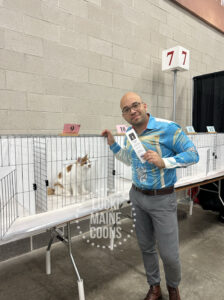

Above is our Maine Coon Poly, Alexa. In the left picture she is with TICA Judge, Johary Gomez. He put her in his longhair kitten final, she was BEST longhair kitten in show out of 21.
Some General Polydactyl History
It is said that at one time more than 40% of Maine Coons were polydactyl. At this time, the exact percentage of polydactyl Maine Coons are unknown, they have gained more popularity in the recent years. The polydactyl trait is believed to have been a part of the Maine Coon breed since even before Maine Coons became a pedigree cat breed. The Maine Coon breed is one breed that the polydactyl trait is prevalent enough to be considered a normal variation within the breed. Polydactylism is not from inbreeding, unlike some incorrect sources may say.
Polydactyl cats were considered by sailors to be lucky, intelligent, and very skilled when it came to catching pests. Due to their extra toes, polydactyl cats were said to be better climbers and have better balance on the rocking ships at sea. Since they were considered lucky, they were known to be favored on ships.
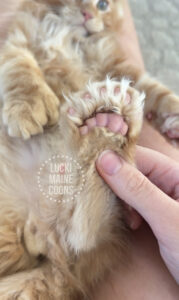
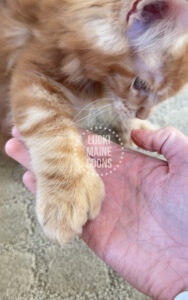
The poly paws above belong to Busta Rhymes from our “OG Rappers” Litter. He is polydactyl on all four paws with six digits on each paw.
Caring for your polydactyl Maine Coon
A common question we receive is, do polydactyl Maine Coons require more care? As long as your polydactyl Maine Coon does not have any injuries to the paw or other problems, you will be happy to know they don’t really require extra care when compared to a non-polydactyl Maine Coon. Polydactyl Maine Coons do have a few extra nails to clip and you will want to ensure that their nails are clipped often enough to avoid the claw potentially curling in and hurting the paw. If you let your cat’s claws get too long, it will cause discomfort. Wellbred polydactyl Maine Coons generally have limited health problems when it comes to their paws, though it is important for them to be examined by your veterinarian regularly.
Maine Coon Polydactyl Lovers
While the love for Maine Coons with extra toes may vary breeder to breeder, owner to owner, polydactyl Maine Coons are still the Maine Coons that many around the world have came to love and adore for many years. We personally have two polydactyl Maine Coon queens, so we do occasionally have polydactyl Maine Coon kittens. You can view all of our Maine Coon kittens on our kitten gallery. If you are lucky enough to meet or see a polydactyl Maine Coon in your life, be sure to give them a pet and take a minute to look at their big paws! Also, if you ever visit Key West, FL, you may see them at the Hemingway House.
